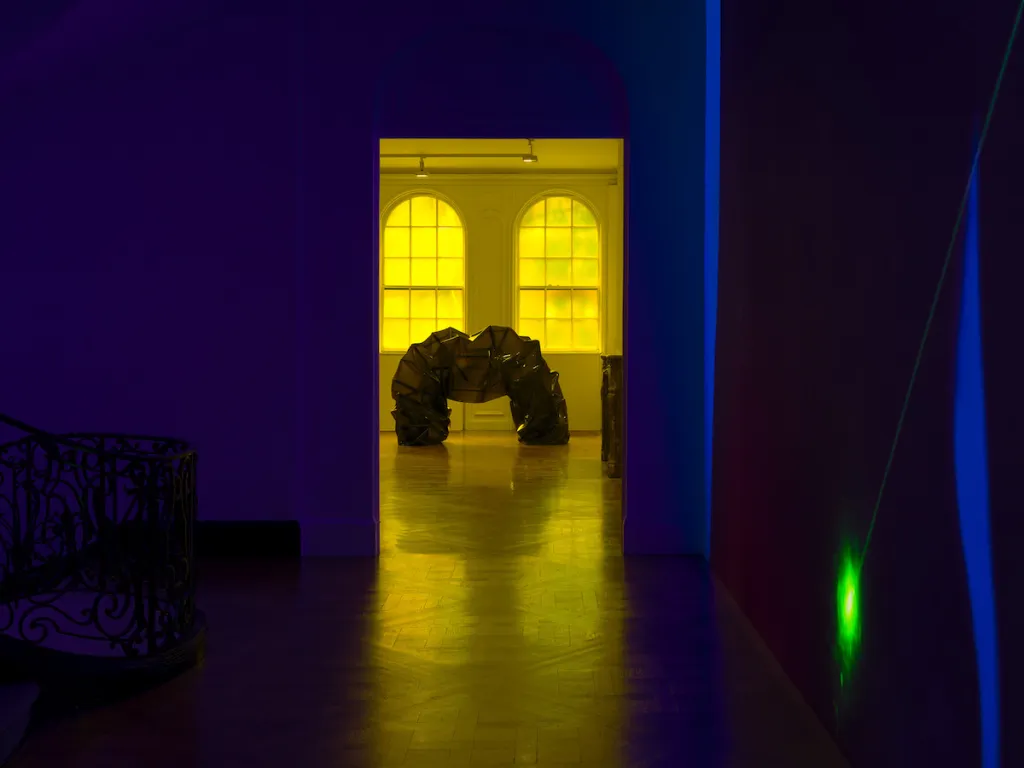I can’t recall a recent exhibition as terrifying—and as moving—as P. Staff’s current show at David Zwirner in New York, the kind of big swing that has become rare in this city. It’s a haunted house of sorts, with spooky sounds and sculptures parceled out across three floors of the gallery’s Upper East Side town house. But there are neither ghosts, zombies, nor evil creatures lying in wait. Instead, the horror evoked here is a dread of the more ambient variety: the horror of having a body.
It’s a topic evoked most explicitly in the exhibition’s central piece, a new video called Penetration (all works 2025). The work depicts a person standing motionlessly in place while a laser is beamed at their bare stomach. Installed in parts, so that it appears to stretch across all three of the show’s floors, the video renders it impossible to see the person’s body in its entirety—the middle level, for example, offers only a view of a towering, tattooed abdomen.
Penetration is not exactly body horror in the classical sense: It contains no images of blood and guts across its 20-minute runtime. But it is deeply unnerving all the same, in large part because of its gargantuan size, which draws a comparison between the gallery and the human body. When this person respires, it begins to feel as though the walls are breathing too.
Mega-galleries like David Zwirner are places you go to forget your body: You go there to admire beautiful, expensive artworks, not to think about what you’re doing as you’re looking at them. In turning this David Zwirner space corporeal, Staff makes it impossible to think about anything other than your body.
P. Staff’s David Zwirner show resembles a haunted house, minus any supernatural creatures.
Courtesy David Zwirner
The windows are covered in a film whose jaundiced shade of yellow suggests urine and bile. Meanwhile, the sounds of a beating heart emanate from a speaker on the ground floor. Right now, being inside this town house feels like being inside a living, breathing thing.
The experience can be uncomfortable, in no small part because this organism’s innards are all jumbled. The speaker broadcasting the sounds of a heart, for example, notably is not in the heart of the gallery. The portion of the video visible on the ground floor, meanwhile, does not contain footage of its subject’s lower extremities. One could conceivably say the show is just as much about dysphoria as it is itself dysphoric.
Staff has previously said their work embodies a form of “trans poetics,” though their films and installations have steered clear of neat political statements. Their contribution to last year’s Whitney Biennial—an installation that first appeared at the Kunsthalle Basel in 2023—included an electrified net hung above viewers’ heads, suggesting both a nervous system and a form of endangerment. The piece was one of the most debated ones in the show, a fact that makes it all the more surprising that this is not just Staff’s first show with David Zwirner, but with any New York gallery. Some critics singled out the installation when they wanted to claim that that Whitney Biennial was chock-full of art that was too evasive, too safe, and too boring. (I disagreed.)
P. Staff’s video Penetration (2025) is split across David Zwirner’s three floors.
Courtesy the artist
The Zwirner show may very well weather similar criticism because Staff clearly has a lot on their mind, even if they don’t always reveal their ideas so readily. Arrayed around this former residence is a group of sculptures that feature wood spikes beneath latex drapes. The sculptures variously resemble partially packed furniture, humans cocooned in bondage gear, and aliens emerging from soft shells. Each work is titled with a variation on the word “distrain,” but it’s never entirely obvious how the pieces refer to the seizure of one’s property or money.
Across the gallery, P. Staff has installed sculptures that do not explicitly state their meaning. They various resemble partially packed furniture, humans in bondage gear, and alien beings.
Courtesy David Zwirner
Still, I’d argue that Staff’s slippery art is engaged with the present, and that the Zwirner show stands as proof. It’s striking to consider what Penetration might signify right now, at a time when an oppressive administration in the US seeks to police the bodies of trans people. (It’s probably worth noting, given the obliqueness of it all, that this London- and Los Angeles–based artist has previously used their work to directly take up “voluntary” sterilization laws in the US, hinting at a broader interest in physiological violence sanctioned by the government.) What might it mean that a green beam of light is aimed at the video’s subject, in what may be a medical examination or perhaps even a surveillance scan? And what might it mean that this person seems totally disaffected by it all, at one point lighting a cigarette in spite of the laser? Staff intentionally offers no tidy answers, leaving their subject in a state of uncertainty that befits our current moment.
And moreover, what might it mean that all of this is so beautiful? The video periodically strobes with deep blue, bold red, and bright white, bathing this lavishly installed show in an array of lush hues. Perhaps Staff is saying that body horror need not only generate fear, for it can also inspire transcendence and searching about who we are and what we’re made of. A pity—or maybe a blessing—that the scariest show of the year closes on October 25, six days before Halloween.
